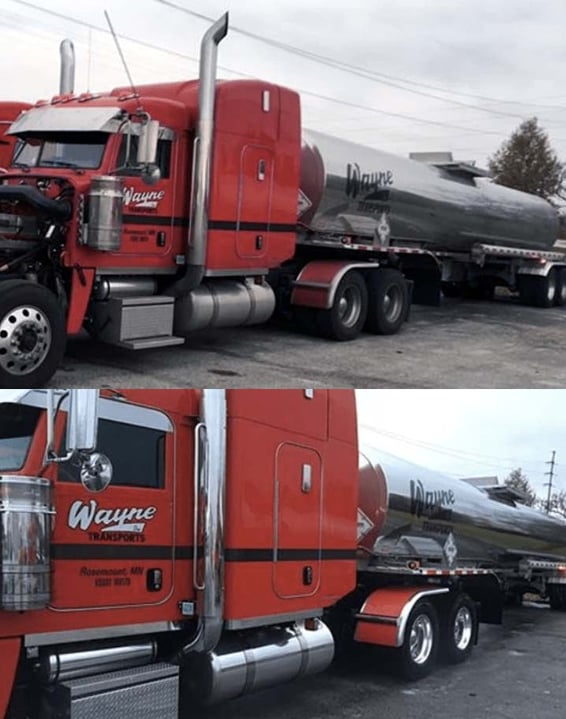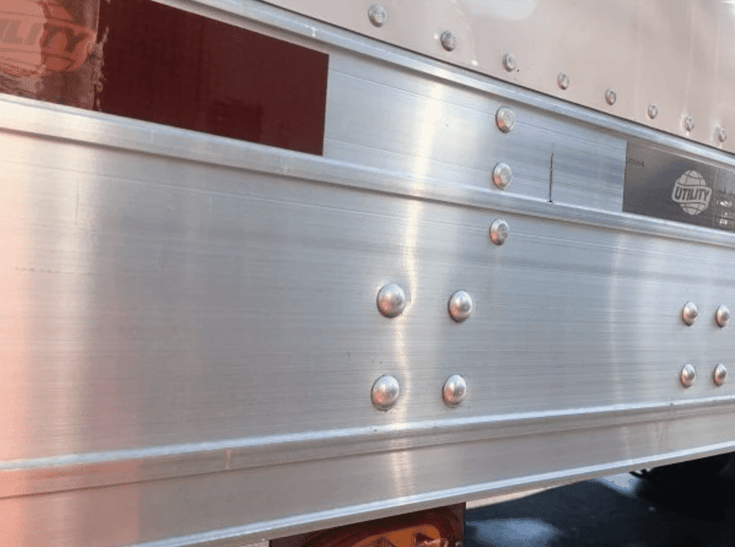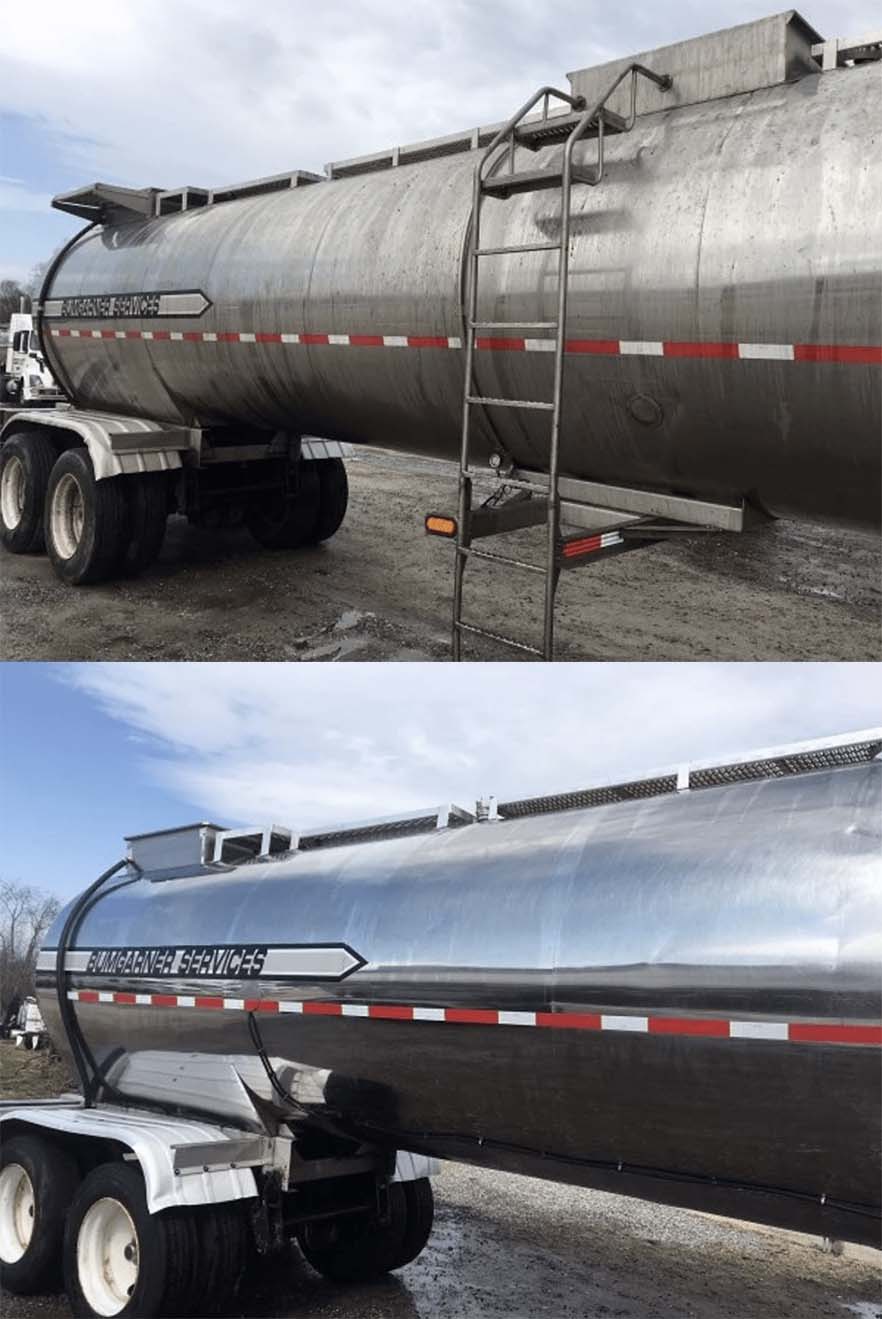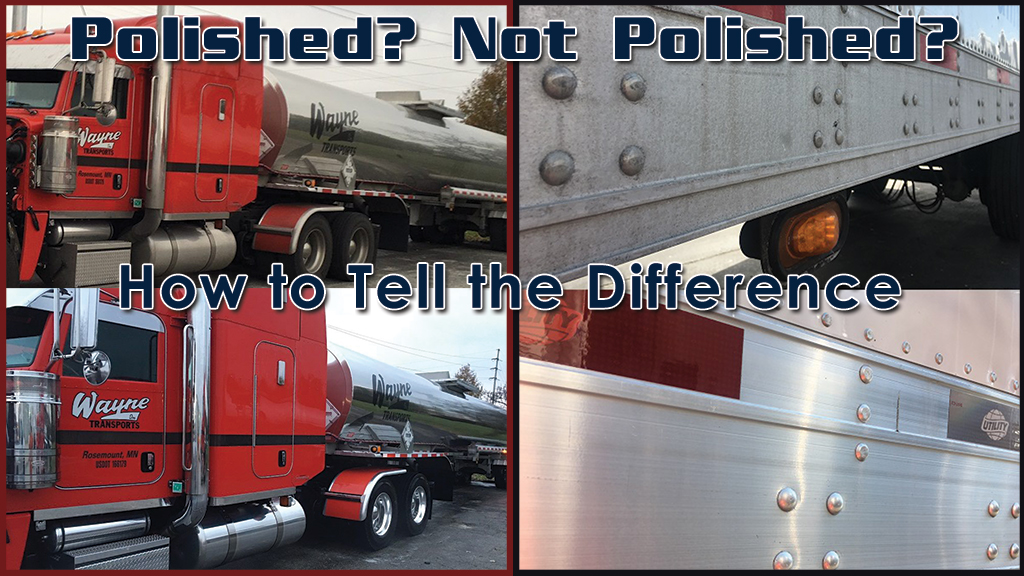In the transportation industry, not all metals are created equal. At quick glance, wheels, fuel tanks, fenders, exhaust stacks, and tankers may have the same metallic appearance but they could still consist of different types of metal, coatings, and finishes.
Overall, the use of stainless steel versus aluminum depends on the type of materials being transported, fuel efficiency, and the desired appearance.
Stainless steel is heavier, more durable, and has increased resistance to corrosion. Stainless steel is used for food-grade purposes as well as other hazardous material transport because it is more resistant to corrosion and damage.
Aluminum is lighter-weight, lower priced, and a little resistant to corrosion. Aluminum is typically used for fuel/oil tanks, bulk tankers, wheels, and for other metal parts on semi trucks and trailers.
It’s important to know the difference between aluminum, stainless steel, and finishes like chrome, dura-bright, and polished aluminum because this will help you choose the most effective & efficient wash process.
How to tell if something is non-polished aluminum
In its natural state, bare aluminum has a satin-silver appearance. Think of the inside of a can of soda. Aluminum is lightweight for transportation and saves the fleet owner a lot of money because of the fuel efficiency and overall cost of materials. Aluminum is also pitted, which means that debris/oxidation/corrosion will fade the surface over time.
A traditional 2-step wash process will neutralize road film, brighten the aluminum, and reduce corrosion. Use aggressive detergents (potentially with an aluminum brightener) for a more transformative wash process in extreme conditions or to produce desired results even at greater dilutions, which saves money.
How to tell if something is polished aluminum
Natural aluminum can be hand buffed and polished to a mirrored finish. Compared to non-polished finishes, polished aluminum is much brighter in appearance, more reflective, and an overall more vibrant silver color.
Aluminum polishing is common with owner-operators as well as small to midsize fleets. Many brand-new fleet vehicles will also come from the factory with polished aluminum. Generally, aluminum polishing is a hand-made process that takes time and comes at a premium cost to create and maintain a more detailed appearance.
Use polished aluminum-safe detergents and a regular 2-step (or friction) wash process to maintain the mirrored appearance without dulling the finish because of chemical damage or drying.
How to tell if something is stainless steel
Stainless steel is much denser and corrosion-resistant and has a naturally satin-silver finish. It is often confused with polished aluminum from a distance. Up close, stainless steel usually does not have the consistent mirrored appearance of highly buffed or polished aluminum.
Because of the factory finish of stainless steel, the surface is much more resistant to corrosion when transporting food-grade goods and hazardous materials. This also makes the surface more resistant to certain types of aggressive detergents and wash processes. You could use similar 2-step detergents for stainless steel as you would with natural non-polished aluminum, but with less aggressive aluminum brighteners.
Other metal finishes
Specifically, chrome-plated metal as well as dura-bright wheel treatments. These grades of metal finishes produce different grades of polished-like appearances as an alternative to the cost of those listed above. While these finishes may not replicate the appearances of those listed above, your cleaning process and detergent selection may need to be adjusted based on the grade of finish and desired appearance.
So how can you tell the difference between polished aluminum and other metals?
The number one question our account managers are trained to ask when we observe (or are told about) polished surfaces is “how often are they being or will they be hand-buffed to a mirror polish?”
As stated above, aluminum polishing is a process that is performed by manually detailing an existing or brand-new aluminum surface. If the answer is “No” or “Never,” then it could mean the vehicle has a stainless steel or an alternative coating for the metal finish.
Where on the vehicle is the shiny or polished finish?
Determine where the shiny appearance of metal is located on the vehicle. In regards to tankers, learn more about what they are hauling. Fuel haulers as well as non-food grade transportation are likely to be aluminum. Food grade and corrosive material transport are likely to be stainless steel.
For semi trucks, exhaust stacks, fuel tanks, bumpers, trim, and wheels may have shinier finishes. If all of them have a shiny finish and are being hand buffed & polished, they are likely aluminum but could be steel wrapped. If trim pieces like bumpers and grills have a shiny finish, but the rest of the metal is dull or satin, these are likely chrome.
For wheels that have a shiny finish but are not being polished, look for stickers or labels that may indicate a dura-bright finish. Blue-label wheels have a polished appearance but must be maintained more often and are less resistant to corrosion. Black label wheels have a brighter polished appearance requiring less maintenance to the finish and more resistance to corrosion.
By understanding the differences between these materials and how to properly clean and maintain them, you can keep your fleet looking great and functioning at its best. If you're unsure about the type of material used in your truck components, consult with a professional or refer to the manufacturer's specifications to ensure that you are using the appropriate cleaning and maintenance techniques.
Polished aluminum is physically hand buffed and shined to a mirrored finish and has no protective coating. This means you must use POLISH-SAFE 2-step products & cleaners that are safe for use – this way you won’t whiten or dull the polished finish.

Non-polished aluminum has more of a satin-silver look and is “shiny” but not to the same mirrored finish as polished. Vehicles like this can use a variety of 2-Step products & cleaners from mild to aggressive, allowing you to maintain the fleet and leave the metal surfaces with a satin silver finish.

Stainless steel is much less likely to corrode and dissolve than aluminum and is often treated with a protective coating to preserve the finish. These types of fleets can often use stronger #2 alkaline soaps & degreasers, but are advised to use milder pre-soaks WITHOUT Hydrofluoric Acid. Stainless steel is more common in tankers that haul oil & petroleum and in food grade transportation.

We offer a variety of products to protect your fleet investment and maintain your company’s image and we have the knowledge and experience to create a customized solution for your wash needs based on your cleaning conditions, fleet, and other factors.


